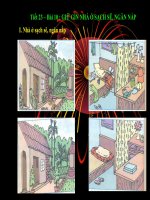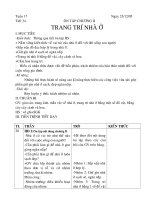100 country houses 100 kiểu nhà ở miền quê
Bạn đang xem bản rút gọn của tài liệu. Xem và tải ngay bản đầy đủ của tài liệu tại đây (25.26 MB, 325 trang )
100
Country Houses
NEW RURAL ARCHITECTURE
edited by Beth Browne
100
Country Houses
100
Country Houses
NEW RURAL ARCHITECTURE
edited by Beth Browne
Published in Australia in 2009 by
The Images Publishing Group Pty Ltd
ABN 89 059 734 431
6 Bastow Place, Mulgrave, Victoria 3170, Australia
Tel: +61 3 9561 5544 Fax: +61 3 9561 4860
www.imagespublishing.com
Copyright © The Images Publishing Group Pty Ltd 2009
The Images Publishing Group Reference Number: 821
All rights reserved. Apart from any fair dealing for the purposes of private study, research, criticism or review as
permitted under the Copyright Act, no part of this publication may be reproduced, stored in a retrieval system or
transmitted in any form by any means, electronic, mechanical, photocopying, recording or otherwise, without the
written permission of the publisher.
National Library of Australia Cataloguing-in-Publication entry:
Title:
100 country houses : new rural architecture / editor: Beth Browne.
ISBN:
9781864703320 (hbk.)
Subjects:
Country homes.
Architecture, Domestic.
Dewey Number: 728.6
Edited by Beth Browne
Production by The Graphic Image Studio Pty Ltd, Mulgrave, Australia
www.tgis.com.au
Pre-publishing services by Splitting Image Colour Studio Pty Ltd, Australia
Printed on 150gsm HannoArt silk matt by Everbest Printing Co. Ltd., in Hong Kong/China
IMAGES has included on its website a page for special notices in relation to this and its other publications.
Please visit www.imagespublishing.com.
CONTENTS
9
10
12
16
20
24
26
30
34
38
42
44
48
52
54
PREFACE
19TH-CENTURY FARMHOUSE
SCOTT MORRIS ARCHITECTS
5 BEECH LANE
SCOTT CARPENTER ARCHITECT
9 POINT HOUSE
ITN ARCHITECTS
ACTON HOUSE
P R E S T O N L A N E A R C H I T E C T S P T Y LT D ( W I T H I N T E R I A )
AHIKOUKA WEEKEND RETREAT
NOVAK+MIDDLETON ARCHITECTS LIMITED
AMELIKA
S H A R O N F R A S E R A R C H I T E C T S P T Y LT D
BALLANDEAN HOUSE
ARKHEFIELD
BENDEMEER HOUSE
WARREN AND MAHONEY
BLACK HOUSE
BGP ARQUITECTURA
BLUMBERG/LYNN HOUSE
ALFREDO DE VIDO
BOWEN MOUNTAIN RESIDENCE
CPLUSC DESIGN CONSTRUCT
BOWER HOUSE
FMD ARCHITECTS
BRAMMELL RESIDENCE
STUDIO B ARCHITECTS
BREAM TAIL HOUSE
S G A LT D ( S T R A C H A N G R O U P A R C H I T E C T S )
58
60
62
64
68
70
74
78
82
84
86
90
92
96
100
6
BUTEL PARK HOUSE
104
BYZANTINE HOUSE
106
CAMOUFLAGE HOUSE
108
CARABBIA HOUSE
112
CHURCH BAY HOUSE
114
CLIFF HOUSE
118
THE CO 2 SAVER
122
COMANO HOUSE
124
COURT ESSINGTON ESTATE
128
THE DAIRY HOUSE
130
DRIFT BAY HOUSE
134
DUBLIN BAY HOUSE
138
EAGLE BAY RESIDENCE
140
EDWARD RIVER RESIDENCE
144
FERROUS HOUSE
148
C R E AT I V E A R C H
A I O LO U A R C H I T E C T S
JOHNSEN SCHMALING ARCHITECTS
DAV I D E M A C U L LO A R C H I T E T T O
DANIEL MARSHALL ARCHITECT
STUDIO B ARCHITECTS
PETER KUCZIA
DAV I D E M A C U L LO E M A R C O S T R O Z Z I A R C H I T E T T I
DAVID ARCHER ARCHITECTS
S K E N E C AT L I N G D E L A P E Ñ A
KERR RITCHIE
SALMOND ARCHITECTURE
CHINDARSI ARCHITECTS
J A C K S O N C L E M E N T S B U R R O W S P T Y LT D A R C H I T E C T S
JOHNSEN SCHMALING ARCHITECTS
FISHERS ISLAND HOUSE
CENTERBROOK ARCHITECTS AND PLANNERS
FLOYD HOUSE
CENTERBROOK ARCHITECTS AND PLANNERS
FOOTHILLS HOUSE
S G A LT D ( S T R A C H A N G R O U P A R C H I T E C T S )
FORMENTERA ISLAND HOME AND OFFICE
MARIÀ CASTELLÓ
FOXGROUND RESIDENCE
S T U D I O I N T E R N AT I O N A L E
GIDGEGANNUP RESIDENCE
IREDALE PEDERSEN HOOK ARCHITECTS
GREAT WALL OF WARBURTON
BKK ARCHITECTS
GUESTHOUSE/GALLERY IN KIYOSATO
S AT O S H I O K A D A A R C H I T E C T S
HAUS WOHLFAHRT-LAYMANN
MEIXNER SCHLÜTER WENDT ARCHITEKTEN
HDX WORKSHOP
BGP ARQUITECTURA
HOF RESIDENCE
STUDIO GRANDA
A HOME IN VALLE D’AOSTA
S I LV E S T R I A R C H I T E T T U R A
HOUSE F
MEIXNER SCHLÜTER WENDT ARCHITEKTEN
HOUSE OCHO
FELDMAN ARCHITECTURE
HOUSE ON EASTERN LONG ISLAND
ALFREDO DE VIDO
CONTENTS (continued)
152
156
158
160
164
166
170
174
178
180
184
188
192
194
198
HUNTER HOUSE
200
IA HOUSE
204
INDIAN NECK RESIDENCE
208
JACKALOPE RANCH
212
JOHANNA HOUSE
216
KANGAROO VALLEY HOUSE
220
KILMORE HOUSE
222
KNOCKFAD HOUSE
226
KOHLHAGEN RESIDENCE
230
KURREKI
232
SCOTT MORRIS ARCHITECTS
BGP ARQUITECTURA
HAMMER ARCHITECTS
TROUT STUDIOS
N I C H O L A S B U R N S A S S O C I AT E S
T U R N E R + A S S O C I AT E S
INTERMODE WITH CARR DESIGN GROUP
D A M I E N M U R TA G H A R C H I T E C T S
4240 ARCHITECTURE
BOURNE BLUE ARCHITECTURE
LIVERMORE HOUSE
MOORE RUBLE YUDELL ARCHITECTS AND PLANNERS
LORD RESIDENCE
STUDIO B ARCHITECTS
MACEDON COURTYARD HOUSE
ZEN ARCHITECTS
MARTINBOROUGH HOUSE
PA R S O N S O N A R C H I T E C T S
MOLLY’S CABIN
A G AT H O M C O .
234
238
240
242
MOUNT TAURUS RESIDENCE
Z I V K O V I C C O N N O L LY A R C H I T E C T S
MOUNTAIN STAR II RESIDENCE
4240 ARCHITECTURE
THE PATON HOUSE
STUDIO JOHN IRVING
PENCALENICK HOUSE
SETH STEIN ARCHITECTS
PENINSULA RESIDENCE
G R E G O R Y B U R G E S S P T Y LT D A R C H I T E C T S
PLUG-IN COTTAGE
MACGABHANN ARCHITECTS
POND HOUSE
LEROY STREET STUDIO
POUND RIDGE HOUSE
HARIRI & HARIRI – ARCHITECTURE
PULL HOUSE
PROCTER:RIHL
QUEENSTOWN RESIDENCE
RICE & SKINNER (IN CONJUNCTION
W I T H M U R R A Y C O C K B U R N PA R T N E R S H I P )
RESIDENCE AMID THE INDIAN PAINTBRUSH
DUBBE-MOULDER ARCHITECTS
RETREAT FOR A MOTHER AND DAUGHTER
LEROY STREET STUDIO
RIDGE HOUSE
HELLIWELL + SMITH – BLUE SKY ARCHITECTURE
RILEY HOUSE II
CENTERBROOK ARCHITECTS AND PLANNERS
CONTENTS (continued)
244
ROBSON FARMHOUSE AT THE ROSSHILL
VINEYARD
K E I T H P I K E A S S O C I AT E S
248
252
254
256
260
264
268
270
272
274
278
282
284
8
286
290
RURAL RETREAT ARCADIA
E L E V E N E L E V E N D E S I G N + D E V E LO P
294
SABER HOUSE
ALFREDO DE VIDO
296
THE SAGAPONAC HOUSE
HARIRI & HARIRI – ARCHITECTURE
298
SAPPHIRE RIDGE
SOLUTIONS ARCHITECTURE LIMITED
302
SELF-SUFFICIENT HOUSE
UTZ-SANBY ARCHITECTS
304
SHALKAI
HELLIWELL + SMITH – BLUE SKY ARCHITECTURE
306
SHIFT COTTAGE
SUPERKÜL INC | ARCHITECT
308
SIMPSON HOUSE
DAVID L ANGSTON-JONES
310
SLOUGH POND RESIDENCE
HAMMER ARCHITECTS
314
STONE HOUSE
G R E G O R Y B U R G E S S P T Y LT D A R C H I T E C T S
318
SUNSHINE CANYON HOUSE
J O N AT H O N S C H LO S S / A R C H I T E C T
320
TAN SHAW RESIDENCE
S PA C E 4 A
TICINO HOUSE
DAV I D E M A C U L LO A R C H I T E T T O
322
TREE HOUSE
SANDER ARCHITECTS
TWO WOLVES RESIDENCE
DUBBE-MOULDER ARCHITETCS
VILLA BLOCH-PASCHE
DL-A, DESIGN L AB -ARCHITECTURE SA
VILLA D
R A H E L B E L AT C H E W A R K I T E K T U R
VILLA ‘UNDER’ EXTENSION
OFIS ARHITEKTI
THE VINTAGE
SUTERS ARCHITECTS
THE VINTRY
SUTERS ARCHITECTS
WALTL RESIDENCE
MCCLEAN DESIGN
WATERFALL BAY HOUSE
PETE BOSSLEY ARCHITECTS
WILKINSON HOUSE
R O B E R T O S H AT Z
WINTER COTTAGE
CHINDARSI ARCHITECTS
WOODEN HOUSE
SPORADICAL
WOOLSHED HOUSE
SALMOND ARCHITECTURE
INDEX OF ARCHITECTS
PREFACE
BETH BROWNE
EDITOR
The 100 contemporary country homes featured in the following pages range from traditional (with a twist) to highly
experimental and their sheer diversity challenges any preconceived ideas regarding a quintessential country house.
Each project exemplifies the shift towards forward-thinking design, which focuses on sustainability and actively engages
in a responsive and responsible relationship with the land. These selected projects are from locations as diverse as
Iceland, the Czech Republic, Germany, New Zealand, Canada, Switzerland, Mexico, Italy, Japan, Sweden, Greece, the UK,
Slovenia, Spain, the USA and Australia. Together they encourage a broader understanding of what ‘country house’ means
to people in different parts of the world, in places where space is sometimes more but often less readily available.
The effects of climate change are becoming increasingly apparent to those who live in remote areas, where lakes
and dams long relied on for water supply and recreation are rapidly drying or where flash floods and snowstorms are
devastating crops and livestock. It is no surprise therefore that environmentally sensitive, low-impact architecture
is becoming the norm for new rural homes. Hydronic heating, photovoltaic arrays and solar panels, cross ventilation
and rainwater collection are becoming almost requisite elements in new building generally, but it is arguably more
incumbent upon those who design and own houses on large tracts of land in areas that are constantly subject to the
forces of nature to harness this abundant natural energy supply and significantly reduce their impact on the environment.
Rural and remote areas around the world encompass a vast array of climates and site conditions. The houses in
this book are sited on pastureland and mountains, beside lakes and vineyards, and in woodlands, rainforests and
coastal regions. Many of the architects faced a combination of challenging site conditions including steep slopes,
high fire danger, landslip or landslide zones, falling trees, high winds and even seismic activity. Some of these houses
were designed to withstand frost, snow, extreme heat and bushfires – all in a single year. Of course, these challenges
also come with their own unique opportunities for dramatic views, absolute privacy and a connection with nature
that is simply unattainable in cities and sprawling suburbs.
The following houses all represent a common aspiration to live within the landscape rather than just admire it from
afar. In many instances, this connection with the environment is subtly created by visually linking structural lines to
those naturally occurring on the site, or by utilising local stone, timber and earth as construction materials so that
the house blends seamlessly with its surroundings and evolves in response to the landscape. Turf roofs are employed
to provide topographical continuity and help to conceal buildings when viewed from higher elevations. Even given the
ample space available in remote areas, many of these houses incorporate enclosed courtyard areas for protection
from wind, fast-changing weather and insects. These courtyards and terraces also serve to maximise passive solar
gain and promote cross ventilation. Another common design theme is the use of multiple, adaptable zones, which
afford a flexibility of space that can be opened up or closed off according to need.
This collection of 100 of the world’s best rural and remote houses was a pleasure to research and is testament to the
talent and creativity of the architects and photographers who have kindly allowed us to publish their work. We hope
you enjoy discovering the work of these architects as much as we have enjoyed compiling this book.
19TH-CENTURY FARMHOUSE
E R I N , O N TA R I O, C A N A D A
SCOTT MORRIS ARCHITECTS
This 110-year-old, 240-square-metre original Victorian farmhouse underwent an addition and renovation that
increased its size to 410 square metres. It is now a fully accessible home for an active family of four living 21stcentury lifestyles.
The addition addresses specific needs while maintaining the integrity and style of the existing house. The design
features of the addition are consistent with the original architectural features, making a seamless transition.
Rising to the challenge of making this country house wheelchair accessible meant approaching the house with a
fresh perspective. The new floor plan allows for a barrier-free zone allowing maximum independence in a beautiful
environment with no resemblance to institutional spaces.
Porch and roof patterns are repeated, the addition is gabled and the chimneys are kept in line along the rooftop, in
keeping with the home’s original style. After that, it was just a matter of paying attention to the details. The exterior
brickwork, windows and gingerbread trim as well as interior floor finishes, paint colours and door and window trims
all match the originals. The bedroom wings are extra large for ease of wheelchair movement and a caregiver’s
presence without the feeling of being crowded. The plan also incorporates a huge media room with fireplace and
ample floor space for entertaining and relaxing.
New landscaped gardens and gently sloping bricked pathways provide easy access to a house that promotes
independent living within a beautifully restored and maintained traditional setting.
10
1
2
5
1
Front view: original house and addition
2
Back view: addition and original house
3
Living room
4
Den
5
View from new deck behind garage
Photography: Philip Castleton
3
4
5 BEECH LANE
K I N G S C L I F F, N E W S O U T H W A L E S , A U S T R A L I A
A white rendered ‘concrete’ box floating over a polished charcoal block base and anchored centrally by a glass
breezeway, 5 Beech Lane is quintessential casual living with a solid dose of bold minimalism.
SCOTT CARPENTER ARCHITECT
The house is set on expansive landscaped gardens and flanked by water. Reed ponds lie along the southern entry
boardwalk and a 20-metre infinity-edge lap pool stretches the entire length of northern boundary.
The house is divided into two pavilions: the sleeping box at the lane end and the entertainment box towards the beach.
The plan then separates into four distinct zones: a guest bedroom wing and guest entertainment area on the ground
floor and private bedrooms and private living spaces on the upper level.
The hub of the home is the breezeway. It is open to the north but protected from the elements by a shielded glazed
roof and a combination of timber battens and fixed-glass louvres. It simultaneously links and separates the four zones,
acting as the central circulation zone and ‘airlock’. The line between indoors and outdoors is subtly blurred as doors
disappear behind walls and decks continue inside. Although the aesthetic may suggest otherwise, the vast majority
of the structure is lightweight timber framing, chosen because it is appropriately low in embodied energy.
While state-of the-art technology has been utilised extensively, the design is driven by strict ESD principles. All rooms
are oriented to the north and protected on the north, east and west by a combination of generous eaves and automatic
external roll-down blinds. External and internal louvres allow for thorough cross-ventilation in all rooms.
Stormwater is collected, stored and reused for the toilet, laundry, pool and garden. Any overflow is stored in a
filtration tank and slowly dispersed into the sand rather than entering the street stormwater system.
12
1
2
1
South façade
2
The house is set among landscaped gardens and overlooks
beautiful Casuarina Beach
16
13
4
16
16
23
18
20
22 19
17
13
14
15
16
L A N E
6
4
13
5
B E E C H
7
4
9
8
12
1
2
3
13
4
5
26
16
15
27
25
28
1
10
11
13
2
24
3
21
23
12
23
20
8
13
Floor Area: 5
Site Area: 2,
16
1
2
3
4
5
6
7
8
9
10
11
12
13
14
15
16
17
18
19
20
21
22
23
24
25
26
27
28
Entry
Light pond
Reed pond
Bedroom
Garage
Lap pool
Spa
Breezeway
Guest entertainment
Alfresco dining
Kitchenette
Storage/services
Bathroom
Laundry
Drying yard
Deck
Dressing room
Master bedroom
Living
Meals
Kitchen
Fireplace
Void
Bar
Theatre
Cellar
Pump room
Surfboard store
6
3
The house is set among reed ponds and extensive
landscaped gardens
4
Floor plan
5
Walls disappear as the alfresco dining deck is
brought inside
6
The basement wine bar and cellar
7
The breezeway is the central circulation core and
the ‘lungs’ of the home
8
The casual guest entertaining area
Photography: Brian Usher – Creative Jungle (2–7); Brent Middleton (8)
7
8
9 POINT HOUSE
DANDENONG RANGES, VICTORIA, AUSTRALIA
ITN ARCHITECTS
This small family house of 135 square metres is located in the Dandenong Ranges, a low mountain range east of
Melbourne. The land is accompanied by a ‘perfect storm’ of issues: the 1.6-hectare site is very steep, dropping
50 metres across its length, and in a high fire danger and high landslip zone. The site is also covered by towering
mountain ash trees, making access and construction a real challenge.
These particular conditions inspired a design influenced by aspects of the early Case Study houses of California.
The landslip issues and potential for falling trees led to the use of an all-steel frame. As the site is on the south side
of the mountain, and in shade for a lot of the year, the glazing was maximised to capture the rare sun and the
spectacular views of Melbourne below. It was necessary to minimise the amount of potentially very expensive
landslip-resistant footings required by having only nine points of contact, with much of the building and outdoor
living space cantilevered over the circular drive required for fire access.
The small, perfectly square upper plan maximised the building’s volume and minimised the more costly exterior
surface area in order to work with the structural system and budget. The house is clad in Colorbond steel for
economy, ease of maintenance and good fire performance. The design also allows for extra rooms to be hung below
the structure without additional footings. The detailing and finishes were kept as simple as possible to allow the
house to act as an unobtrusive frame to the dramatic 360-degree forest views. The house has since been struck by
lightning and one falling tree, but is still going strong.
16
1
View from southeast corner of house
2
View from corner of deck to living room
3
Upper floor plan
4
Lower floor plan
1
4
6
5
10
8
7
9
3
0
5m
1
2
3
4
2
1
2
3
4
5
6
7
8
9
10
Study
Bathroom
Laundry
Deck
Living
Kitchen
Bedroom 1
Bathroom
Bedroom 2
Entry
5
5
Bedroom 1
6
Living room
7
View to bathroom and bedroom 1
8
Bathroom
9
View from study at sunset
Photography: Aidan Halloran
6
18
7
8
9
ACTON HOUSE
A C T O N PA R K , TA S M A N I A , A U S T R A L I A
P R E S T O N L A N E A R C H I T E C T S P T Y LT D W I T H I N T E R I A
Acton House is located on the northern edge of a broadacre rural property in the heart of Acton Park, Tasmania. A row
of pine trees lines the northern boundary, with access to the site via a long driveway from the south. The project brief
was to provide a contemporary residence free from clutter and offering a clear separation between the public and
private spaces of the house. As a result the plan is composed of two pavilions: one for living and one for sleeping.
The house has been sited to maximise views over the property’s rural setting, while making use of existing vegetation
on the site to conceal neighbouring properties. Its orientation aligns with the row of pine trees, and terminates with
the broad landscape view to the east.
Stretching out into the landscape, a stack bond concrete block wall defines the entry to the house. A row of trees was
planted on this axis to help further delineate the entry. When these trees mature they will also conceal an existing
kennel building on the site. On approach to the front door, timber decking aligns with the concrete wall and continues
into the house, through a window and out the other side, enhancing the connection to the outside.
Masonry walls flank both pavilions in an east–west direction, setting up a dialogue with the row of pine trees and
providing a sense of containment from within. The pavilions are connected by a gallery/study area adjacent to the
entry. A deck and courtyard space are located on either side of this gallery, providing external areas that are sheltered
from the wind at different times of the day. These spaces also provide the owners with privacy from a riding trail
that circles the property.
1
0
20
5m
2
1
Floor plan
2
Northern elevation
0
3
3
Elevation
4
Front entry
5
Private deck space
6
View of the living space
7
View of the kitchen
8
Gallery space with concealed study
Photography: Jonathan Wherrett
4
22
5
5m
6
8
7
AHIKOUKA WEEKEND
RETREAT
W A I R A R A PA , N E W Z E A L A N D
Located in an old apple orchard in the rural district of Wairarapa in the southern region of New Zealand’s North Island,
the Ahikouka Weekend Retreat was conceived as a series of apple boxes sitting lightly on the land. The intention was
NOVAK+MIDDLETON ARCHITECTS LIMITED
to reinterpret the New Zealand building tradition, the crafting of timber and the expression of structure, cladding,
lining and joinery in a raw and unique way.
The building consists of two simple boxes oriented on the primary axis of the site and linked by an external gallery.
The boxes have been positioned on the site to maximise the visual expanse, while using the eastern shelter belt to
create a sense of enclosure. The structure of the boxes has a logical and coherent rhythm reminiscent of apple packing
cases stacked and ready for transport. The building skin alludes to its internal functions, utilising transparency for
the living zones and solidity in the private spaces.
The entry is intentionally understated, opening to a large interconnected open-plan living area, positioned centrally
to provide spaces where various family holiday functions can occur independently but remain connected. Bedroom
spaces have been positioned at each end of the building and are more discrete than the living spaces to provide
sheltered and restful areas, removed from the interactive living environment. Long slot windows have been positioned
adjacent to bunk beds to provide individual control of view, sun and aspect. The living spaces open on both sides to
the outside and the sun, analogous to a tent, while the bunkrooms remain enclosed and cool.
The unadorned natural timber façade provides a connection to nature and is set to weather in its rural environment.
The concept incorporates simple sustainable design principles of water collection, ‘wetback’ water heating, waste
management, double glazing and material selection.
The strong uncomplicated solid form with its inserted expanse of glass heightens the experience of the site, affording
the feeling of being close to, but protected from, the elements. This creates a sense of shelter in close connection
with the environment and provides a setting that captures the essential spirit of the New Zealand holiday retreat.
1
24









